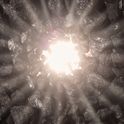Observation of neutrinos registered by the IceCube experiment
As you read this, 10m neutrinos are passing through your eyes every second, at almost the speed of light, unseen. These will o’ the wisps are the most enigmatic particles in the universe. They are like electrons except that they have no electrical charge and almost no mass. They are impervious to electric and magnetic forces, and interact with matter through the “weak” force—the feeblest of the natural forces other than gravity. So their faint affinity for matter makes neutrinos very hard to detect.
Neutrinos are produced in nuclear transmutations, such as the decay of a radioactive element in a rock. They are also produced during the production of power in a nuclear reactor, or in the fusion processes that fuel the Sun and stars. The chance of capturing a neutrino is so small that when Wolfgang Pauli, the Austrian theoretical physicist, proposed its existence in 1930, in order to explain some properties of radioactivity, he wagered a crate of champagne that no one would ever be able to detect the phantom. The chance of observing a neutrino is small, but not zero—and if the source of neutrinos is intense enough, occasionally you can be lucky and capture one. In 1956, two Americans, Fred Reines and Clyde Cowan, did just that at a nuclear reactor in an experiment that was aptly named “Project Poltergeist.” Pauli paid up.
Some neutrinos are coming up from the ground beneath our feet, emitted by natural radioactivity in rocks. But most of the neutrinos that are presently all around you were born in the heart of the Sun less than 10 minutes ago—just a short while before you decided to read this article. In just a few seconds the Sun emits more neutrinos than there are grains of sand in the Sahara, a number greater even than the number of atoms in all the humans who have ever lived.
If we could see neutrinos, our nights would be as bright as day: solar neutrinos shine down on our heads by day and up through our beds by night—the earth is almost transparent to them. It is not just the Sun which acts as an emitter; all stars fill the void with neutrinos.
But the neutrinos born in the Sun and stars, numerous though they are, are relative newcomers. Most of the neutrinos in the cosmos are fossil relics of the Big Bang, and have been travelling through space unseen for over 13bn years.
To capture even a few solar neutrinos, produced by our nearby sun, requires thousands of tonnes of material for use as a detector.
Neutrinos produced further away—by stars in our galaxy and beyond—are faint compared to solar neutrinos, as is starlight to daylight. To have any chance of capturing these fainter particles requires detectors containing over a cubic kilometre of matter.
The ingenious solution is IceCube, an experiment at the South Pole, which uses the ice in the Antarctic as a natural detector of neutrinos. It has detected neutrinos born outside our galaxy, and is looking into the galactic core of the Milky Way—a region that we’ve never been able to see before.
A new form of science, neutrino astronomy, is blossoming. The chance of capturing neutrinos grows in proportion to their energy, which enables them to be studied in high-energy experiments at laboratories such as Cern. Even so, detectors have to be hundreds of cubic metres in volume. Neutrino astronomy began with the quest to detect solar neutrinos—their vast number made the goal possible. But even though Ray Davis, an American scientist, began his experiment to detect neutrinos in 1960, it took 30 years before he finally convinced doubters that he was indeed seeing solar neutrinos.
When a solar neutrino hits an atom of chlorine, this is converted into a radioactive form of argon and from this, the collision of a single neutrino can be inferred. Davis used 400,000 litres of cleaning fluid, which contains chlorine, built his experiment a mile underground, where the earth shielded it from cosmic rays, and detected solar neutrinos at the rate of one or two a month, for three decades. He lived to win the Nobel Prize in 2002, aged 87.
By the 1980s vast underground pools of pure water were used to detect neutrinos.
When a neutrino hits an electron in the water or ice, it is like the head-on strike of a billiard ball. This makes a flash of light, which can be picked up by special electronics that can also measure its energy, when it hit, and where it came from.
On 23rd February 1987, astronomers noticed a supernova in the Large Magellanic Cloud, a satellite galaxy of the Milky Way in the southern skies. According to theory, this explosion should have emitted a blast of neutrinos numbering 1 followed by 59 zeroes. Having travelled across space for 170,000 years, the thinned-out shell of the supernova neutrinos passed through the Earth in a 15-second period that day. The underground experiments detected a handful of neutrinos from the supernova. By detecting this momentary blast, scientists had their first look into the workings of a supernova. The data gathered that day confirmed that a supernova is the result of a massive star collapsing to form a “neutron star,” the densest and smallest stars in the universe.
That supernova in 1987 was the first time we saw any cosmic source other than the sun for neutrinos. And so it remained for 25 years, until now. With the advent of IceCube, neutrino astronomy promises to give us a new way to view the cosmos. For hundreds of years we have looked with our eyes, using the rainbow of visible light to observe the universe. Light is a form of electromagnetic radiation, and for the last 60 years we have expanded our electromagnetic sensors into the realms of invisible light: with radio and infra-red astronomy at one extreme; and ultra-violet, X-ray and gamma ray astronomy at the other. With neutrinos we will, for the first time, examine nature by means utterly outside this electromagnetic spectrum. What do we hope to learn?
The spectrum of light from a distant star is like a barcode. By analysing the light, scientists can establish which atomic elements are present within the star. The energies of neutrinos also form a spectrum, which reveals how those elements were formed. This is because the processes that transmute elements, such as hydrogen to helium in our sun, also emit neutrinos, and different transmutations are signalled by neutrinos of characteristic energies. Thus by measuring the energies of incoming neutrinos, and looking for peaks of intensity at various energies, it will be possible to deduce which nuclear processes have taken place at their origin, millions, maybe even billions of light years away. Most exciting may be to detect neutrinos that were emitted during the first moments of the Big Bang. This will enable us to peer directly into the Big Bang for the first time.
Now, 13.7bn years after the Big Bang, its heat is a mere three degrees above absolute zero: minus 270 degrees Celsius. This “microwave background” radiation was discovered in 1964, and is part of the legacy of astronomy using the electromagnetic spectrum. From its temperature today, and the known rate of expansion of the universe, we can play the clock back and estimate the temperature at earlier epochs. This shows that in the 350,000 years after the Big Bang, the universe was hotter than the surface of our Sun. The Sun is opaque to light, as it is to electromagnetic radiation of all wavelengths. It is too hot to allow the waves to pass, and the same is true of the hot Big Bang: to try to look into those early years by means of telescopes that use electromagnetic radiation is a hopeless task. However, neutrinos that were produced before that time will still “shine.” The challenge is to detect them.
When a neutrino hits an atom, in water for example, the neutrino may turn into an electron. If an electron is moving fast enough, as it flies through the water it emits flashes of light, known as Cerenkov radiation. Thus the flight of the electron lights up and from its track, the path of the original neutrino is inferred. The chance of a neutrino interacting with matter is so small that a vast amount of target is needed. In the Antarctic, the ice pack does the job.
Ice in the Antarctic is not like ice that we are used to on a cold winter’s day. In the Antarctic, snow has fallen on ice for much longer than recorded history. A mile beneath the surface, the pressure is so great that all the air bubbles have been squeezed out, leaving ice so pure that light flashes, produced by neutrinos, can travel undimmed for hundreds of metres in the darkness.
Photomultiplier tubes, devices for recording the tell-tale flashes of light, have been lowered into the ice, down shafts that are made by a special drill that sprays out hot water to melt a hole. The detector is attached to a long cable, lowered into the ice and then frozen in place. From then on it records data continuously. The array of detectors covers about a cubic kilometre of ice, a volume that could fill one million swimming pools. The set-up is so sensitive that each day it records up to 300 neutrinos produced by cosmic rays hitting the atmosphere from all around the globe. Some come from directly above the Antarctic, while others have travelled all the way through the Earth, from the North Pole.
In November 2013, IceCube announced that it had detected 28 neutrinos that most probably originated outside our galaxy. Already a handful of neutrinos have been detected with energies so vast that their source is a mystery. As the 10-minute travel time of solar neutrinos is very long on the scale of the nanoseconds in the laboratory, so are the journey times of cosmic neutrinos correspondingly greater again. In travelling from the most distant parts of the universe, over such immense timescales, exotic properties of neutrinos might be revealed.
The aim of neutrino astronomy is to know what there is in the universe that we cannot see in ordinary light, or in electromagnetic waves of any wavelength. The hot early universe is a goal. We can simulate its heat by colliding particles at high energy, such as at the Large Hadron Collider, and from the results we have deduced how the universe behaved in those first moments. But we have not been able to observe the real event because the early universe is opaque to electromagnetic radiation. Is there a spectrum of neutrinos analogous to that of the microwave background radiation? Comparing the two will give clues to how matter was formed.
This is indeed “blue skies” research. We have no idea what we will find; therein is the excitement and opportunity of such science. Nonetheless, history suggests that there will be surprises—the creation of matter in the Big Bang is the source of everything that we see today, and neutrino astronomy offers a unique means to learn how it came about.













